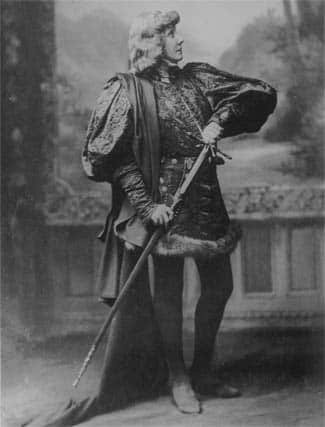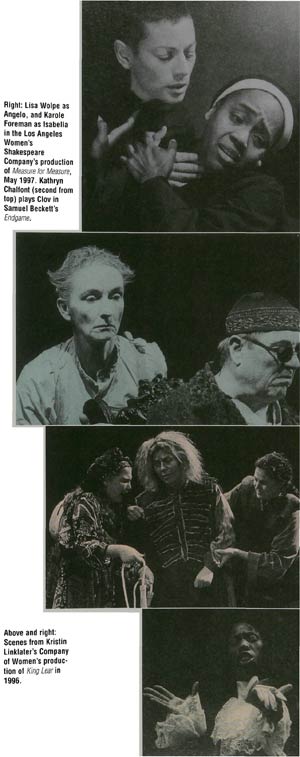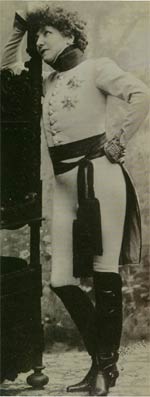by Marilyn Stasio

When Sarah Bernhardt played Hamlet in 1899, two French critics disagreed so violently about her performance that they marched over to the Seine and onto the Isle de la Grande Jatte, where they fought a duel in which Bernhardt’s champion was seriously wounded. All Paris and, indeed, most of the literary world, took sides in this rancorous dispute, which turned on the ludicrous question of whether Bernhardt, a theatrically towering but physically diminutive actress, could lay legitimate claim to a character described in Shakespeare’s text as “fat and scant of breath.
As theatrical brouhahas go, the fatty fracas was not as murderous as, say, the 1849 Astor Place Opera House riot in New York, in which 31 lives were lost when a gang of admirers of the American actor Edwin Forrest attacked partisans of his English rival William Charles Macready, who was performing Macbeth. All the same, the vitriolic rhetoric unleashed by the appearance of a great female actress in a great male role was genuinely fierce – and awfully silly.
“You always get into silly issues when a woman plays a man’s role,” says the actress Kathleen Chalfant, who was nominated for a Tony Award in 1993 for the three male roles she took in the Broadway production of Angels in America, and who also won acclaim in the role of Clov in Samuel Beckett’s Endgame. Like Hamlet’s girth, the matter of how a man crosses his knees qualifies as one of those silly issues, says Chalfant, who had problems with the movement herself. “I finally had my husband sit in a chair, with no clothes on, and cross his knees, so I could see where his balls go.”
As Gerda Taranow points out in her exhaustive scholarly study The Bernhardt Hamlet: Culture and Context, “in opera, in ballet, and in theatre, the female travesti role had by the 19th century become a standard convention.” The ballet was so “saturated” with female performers in male roles that, “outside of Russia and Denmark, male dancing was seriously impaired in the 19th century.” And stage companies in France, England, and America were so hospitable to women in classical male parts that by the time Bernhardt undertook Hamlet, more than 50 actresses had already had a crack at the role.
Now, a century later, with actresses taking to the practice again, you’d think that the sight of women in male trousers or tights would be familiar enough not to stampede the livestock or send the men dashing out to duel. But, however lofty the role or ambitious the performance, any woman who takes the part of a man still finds herself being judged on the silly issues. (She’s too fat or too slender or too soft or too supple or simply too graceful when she crosses her knees to be entirely convincing as a “real” man.) How come? Because criticism formulated on physical principles is still the safest, sneakiest way of saying (without losing one’s credibility as a critic) that women can’t play men.

“I had no idea that I was about to be convinced that women cannot ‘do’ men’s parts,” the American actress Elizabeth Robins said in 1900, in a commentary on Bernhardt’s Hamlet she wrote for The North American Review. Refusing to weigh in on the avoirdupois controversy, Robins instead attacked Bernhardt for playing Hamlet as “a scampish schoolboy.” Daring and irreverent, it was an interpretation that deliberately undermined the Romantic tradition of that sexy, brooding, mercurial prince of melancholia who was for 19thcentury audiences “a symbol,” as Taranow puts it, “of the spiritually embattled hero: sensitive, creative, philosophic, irresolute, pessimistic, cosmic, and doomed.”
Unlike the popular, contemporary Hamlet of Edwin Booth (“Hamlet with all his sensitiveness, profundity and subtilized passion emphasized”), Bernhardt’s impetuous young prince was too “crude” and “frankly comic” for Robins’ romantic taste. “It was not the gentle prince, the melancholy Dane, that we were seeing, nor any man of any sort,” she wrote, “but an amazingly good imitation of a high spirited, somewhat malicious boy.”
Calling an actress “boyish” is no compliment in the lexicon of theatrical criticism. It is a snide way of ridiculing her performance and diminishing her person – and it is still widely practiced by critical pundits. Writing in New York magazine in 1982, John Simon termed Diane Venora “a runt of a prince” in the role of Hamlet at the New York Shakespeare Festival. “She does not for a moment pass for a man,” Simon said, eerily echoing Elizabeth Robins’ criticism of Bernhardt. “A twelve-year-old boy, yes, though a rather small one – with all manner of little-boyish tricks and mannerisms – and, as a colleague remarked on the way out, a very creditable Peter Pan.”
Another technique for landing a dirty critical punch is to accuse an actress of over-emoting in a manner presumed to be specifically “womanly,” rather than simply human. When the Irish-born actress Fiona Shaw gave her striking interpretation of Richard II last year, the British press bit her in a hundred places for being too wild, too emotional, too intense, too frenzied, too flaming – language suggestive of a Victorian physician diagnosing a case of uterine hysteria.
Probably the most cutting criticism of women playing men’s roles is the feminist charge that women shouldn’t be playing men in the first place.
“This is a very conflicting issue for a feminist in a post-feminist period,” says Barbara Scofield, formerly director of undergraduate theater at the University of Missouri in Kansas City. “If you believe that women should be offered as broad an opportunity as men to express their experience of life as human beings, then you have a dilemma with women in male roles. Part of you believes that women in theater should be promoting the work of women.”
The conflict is even more acute when women take on Shakespearean roles, according to Scofield, who is writing her doctoral dissertation on the two pre-eminent women’s Shakespearean acting companies in this country, the Boston-based Company of Women and the Los Angeles Women’s Shakespeare Company. “Shakespeare is the King of the Dead White Male cultural icons, just like Elvis is the King of Rock and Roll,” she says, “so there is tremendous criticism from feminists about doing the work of a playwright who embodies the white male patriarchal culture of the western world.”
Sarah Bernhardt weathered the critical storm in Paris in 1899 and took her production of Hamlet to Austria, Switzerland, Hungary, South America, the United States, and England. Today, all-women Shakespearean companies continue to explore the classical canon and, in the process, to inspire other female theater professionals to follow their lead. A little criticism isn’t about to make this phenomenon go away, because women of vision have something to teach western civilization about its dramatic literature.
One of these visionaries is Kristin Linklater, the artistic director and cofounder (with feminist psychologist Carol Gilligan) of the Company of Women. “Our mission,” as she defined it in 1990, “is to bring the voices of women and girls into the mainstream of live theater in order to add fresh resonance to the ancient power of theater to illuminate and heal its community.”
The vision part, drawn from her seminal work on vocal theory and technique, Freeing the Natural Voice, has to do with Linklater’s belief that the human body can be transformed – “on a molecular level, as well as on an imaginative level” – when the “natural voice” is freed. “Freeing the natural voice means removing the conditioned defenses and limitations of expression that manifest vocally in muscular tension,” explains Linklater, who currently teaches in the graduate theater department of Columbia University in New York City. “Once you release those conditioned habits, you free a voice that has a range of three to four octaves.”
These “expanded female voices” are able to accommodate male characters of great size, Linklater says. “It was never our intention to interpret Shakespeare’s male characters from a narrow female perspective,” she points out, but to “absorb” them into the enriched psychic and emotional resources of the freed voice. Through the process, the performer finds a source of “dormant energy” that, when activated, can generate “a sense of being possessed.”
Linklater experienced that feeling of possession herself, when she played King Lear and multiple male roles in Henry V. “I found that, in entering these male worlds, I had tapped a source of psychic and physical power that was intoxicating,” she says, “so much so, that when I stepped out of the role and back into my woman’s life, the question was: Now, where did that energy go?”
This is the kind of talk that can make a feminist queasy, with its implication that women must assume male roles in order to access these hidden pools of psychic and physical energy. But, as Barbara Scofield points out, the theory is entirely consistent with Carol Gilligan’s groundbreaking studies in the psychology of young girls. “Freeing the natural voice,” says Scofield, “means freeing the original female voice. . .the female voice before it came into conflict with the stifling patriarchal culture and was silenced.”
Other actresses who have played classical male roles confirm the sense of transformation that made Kristin Linklater feel “possessed” when she played King Lear. “It changed me,” says Lisa Wolpe, of her experience in the role of Richard III. “I think it made me a better person because I explored a dark side of myself and, having brought it to light, I was able to choose whether to be a relentless force or a collaborative force in my own life.”
Wolpe, the founder and artistic director of the Los Angeles Women’s Shakespeare Company, says she was not seduced by the predatory king’s evil soul – but she was exhilarated by the opportunity to plunge into its blackness. “As a woman, I am always pressing myself to be nurturing, collaborative, and peaceful in the world,” she says, “so it was liberating to be able to explore, through this character, my voracious, ambitious side.” She adds that it was also “strengthening to break through those constricting rules of order that govern the behavior of women, pressing them to be invisible and supportive of the status quo.”
This intoxication that women experience when they play men’s roles seems to derive, in large part, from the innate political power that masculinity confers. Although critics like John Simon imply that women take male roles out of gender envy, it seems to be the power, not the masculinity, that women find irresistible.
According to Kathleen Chalfant, “What men have is natural authority in the world, and you don’t realize that until you play a man.” She was forever getting the directorial note that she was “not regal enough” when playing queens and other female figures of authority. “You think you’re being very regal. You stand up straight, walk with dignity, and you think you are being very firm and authoritative. But what you’re really doing is insisting on your strength from a position of weakness,” she says. “Playing a man made me feel entitled, so that I didn’t have to insist on my authority.”
Clearly, actresses have much to gain, on an artistic and technical level, from taking male roles. To Barbara Scofield’s way of thinking, that alone should justify the practice of playing against gender, especially in the monumental Shakespearean roles. “So many actresses just have this longing to do the work,” she says, “to speak those words, to feel those feelings, to be that enormous. Women are not often given the opportunity to be enormous. It’s a tremendous feeling for an artist.”
At the same time, there is something to be said for the fresh insights that women bring to the male roles they play and the illumination that these insights cast on familiar texts. Kathleen Chalfant speaks of the profound sense of desolation that struck her when Clov leaves Hamm at the end of Endgame. “Although Clov is an androgynous figure and is always played by a man, the relationship between Hamm and Clov has often been taken to be the relationship between Beckett and his wife,” says Chalfant. “When you see it as a marriage, in which Clov is in the apparently subservient position, you really feel it when he walks out on someone who is absolutely helpless.”
To Lisa Wolpe, the misogyny of characters like Henry V, Richard III, and Angelo in Measure for Measure leaps from the text when the lines are spoken by a woman. “Our audiences love the seduction scenes,” she says. “The misogynist lines always get huge laughs, because you really hear them when a woman is the seducer.”

“The huge revelation for me,” says Barbara Scofield, “was how audiences learn about themselves when they are confronted by their own stereotypes. Time after time, people said to me, ‘I came in with prejudices. I came in expecting a freak show.’ And always, after the first 15 minutes or so, they get caught up in it and they are able to see through their own prejudices” It is by illuminating the core issues of a text, however, that gender bending really wins its suit to be taken seriously. Maureen Shea, who has directed for both the Company of Women and the Los Angeles Women’s Shakespeare Company, offers example after example of how text is transformed when women play men – especially when they play them in the act of making war.
“A different thing happens with the violence, because a woman’s experience with violence is completely different from a man’s,” says Shea, who is director of theater of Emerson Stage in the division of performing arts at Emerson College in Boston, where she also teaches. “Men’s childhood playing at war games skews their sense of violence, because they come to the stage still ‘playing* soldiers and cowboys. But women don’t play at violence as children. We don’t have that experience with war. So, when you put a sword in a woman’s hand there’s much more danger, because a woman takes it more seriously. You never feel, as you do with the guys, uh-oh, here comes the fight scene. When it’s women with swords in their hands, it’s not a fight scene – it’s a scene of violence.”
Kristin Linklater was angered when she heard critic John Simon say, as he watched a woman play a traditional male role in Henry V, that, “it was ridiculous seeing women trying to play soldiers,” since the whole point was to show that war is itself an unnatural act. “If women aren’t supposed to make war,” she says, “then why are human beings doing it?”
Another area to which female performers bring special insight is the domestic front. Over and over, theater professionals say that Shakespearean scenes between marriage partners or parents and children take on more emotional depth with women in the roles.
For Maureen Shea, one such revealing moment came when Frances West, playing Essex in Henry V and telling of the death of Suffolk spoke the line: “And all my mother came into mine eyes and gave me up to tears.” The connection the actress made, according to Shea, was the connection with her own mother, and the reading became profoundly moving. “The relationship between a woman and her mother is totally different from the one between a man and his mother,” says Shea, “and when Frances West spoke that line, in that way, I heard it for the first time. I heard the whole text differently.”
A hundred years ago, Elizabeth Robins conceded that Bernhardt’s Hamlet had the same emotional force. “It does, perhaps, take a French tongue to utter the word ‘father’ with such an effect,” she wrote, “but certainly, having seen a good many Hamlets, I never got so vivid an impression of the warm, personal relationship between the buried Majesty of Denmark and his son as Madame Bernhardt gave me.”
Perhaps, to steal a line from Hamlet, “Though this be madness, yet there is method in it.”
Marilyn Stasio is a columnist for The New York Times and frequently writes on theater for national publications.
